Fishing is a sport that involves using a large variety of different lures, rods, reels, and other gear items to give anglers every advantage they can get on the water. For hundreds of years, fishing lures have evolved from a very simple wooden plug concept to highly versatile, deep-diving baits that mimic the action of bait fish to an astounding degree.
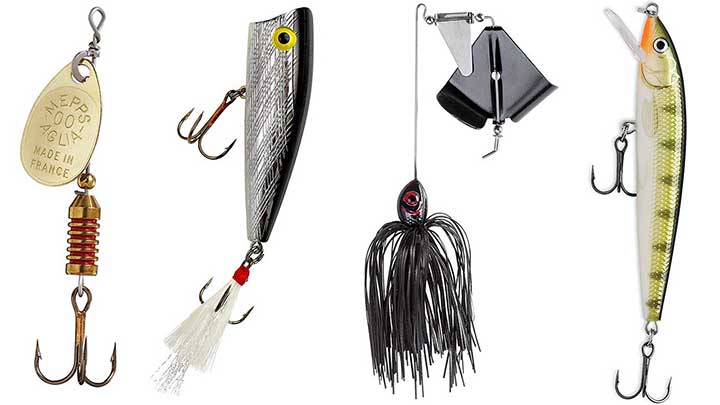
In recent decades, there has been an explosion of fishing lures as companies are increasingly producing newer and better types of lures to give anglers an edge over the competition. For anglers who are just getting into the sport, it can be tough to understand just what these lures are used for and how they should be applied in the pursuit of various game fish species.
In this article, we will discuss some of the most common types of lures that are currently on the market today. The best lure to use will depend on the type of fish being targeted and the fishing conditions.
Here Are the Types of Lures
1. Inline Spinners

Many anglers start out fishing with inline spinners as these are a highly versatile lure that’s capable of catching bass, trout, bluegill, and many other species. Also known as rooster tails if there is a hair skirt, inline spinners are a great choice for freshwater fishing. They are a great choice for novice anglers who are making the first-time transition from natural bait to artificial lures. The advantage of these lures is that lots of water can be covered in a short amount of time. This helps find out where the fish are located. These work best when fish are feeding agressivly.
Inline spinners are designed to mimic the action of a small bait fish swimming through the water. The lure may have a variety of different designs, but one common factor is that it features a single blade that is typically in the shape of an oval or some other rounded model. As an angler retrieves the inline spinner, the blade, or spinner, turns to create a fluttering motion and attract the attention of nearby fish.
This fluttering motion is detected by fish through vibration in the water. The spoon’s bright silver, gold, or other metallic colors also works to attract a fish’s attention as it looks much like a bait fish swimming through the water. Inline spinners work effectively in muddy, stained water, as well as clear water.
2. Northern Pike and Bass Spinner Baits
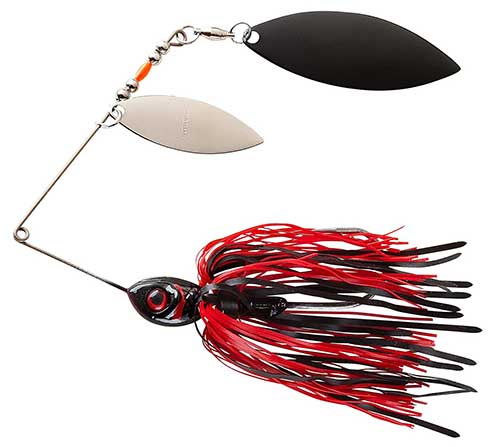
Bass spinner baits are somewhat similar to inline spinners. However, spinner baits have a larger profile and can be fished slower and deeper than inline spinners. Spinner baits have one or more upper blades and a lower jig like body. The blades help to add vibrations and flash to attract nearby fish. The body gives a solid fish-like profile for the fish to strike.
Made to be used with larger, heavier tackle, spinner baits can be thrown a far distance and will mimic the action of a large fleeing bait fish. They produce a high level of vibration, which often arouses the curiosity of larger bass, northern pike, musky, or pickerel as it runs through the water.
Spinner baits come in a huge variety of different sizes, as well as colors and other modifications that let anglers tailor the lure to their own specific needs. The best lure will depend on the fish size, water color, lighting conditions, and depth of the water. It’s usually a good idea to try and match the colors of the spinner bait to the color patterns on bait fish in the lake, river, or reservoir you’re fishing in. Some newer, more advanced spinner baits even have a specially designed ‘head’ that appears to be modeled after a minnow, making the overall lure appear more realistic as it is being retrieved underwater.
3. Surface Poppers
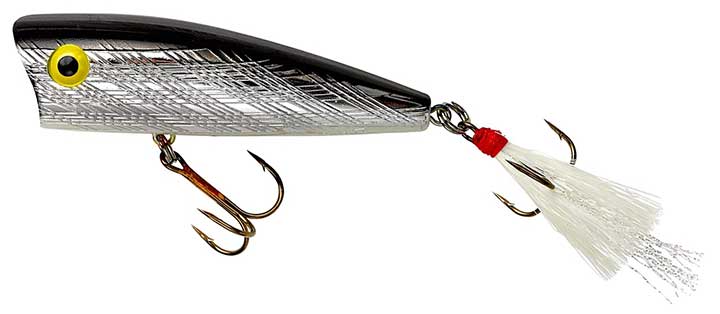
Ask any angler what the most exciting lure choice is in their opinion and many will point to a surface popper. These baits are usually slow-going while being used on the water, but once a fish strikes at it, things can instantly become more exciting. There’s nothing quite like a large bass attacking a surface popper out of nowhere on a calm, midsummer evening just before dark.
These lures come in a variety of size options and designs as they can sometimes mimic a floating, wounded bait fish, or other prey species like crickets, frogs, or mice. They work by the angler literally ‘popping’ the lure across the surface of the water in short, sporadic bursts. These pops will often catch the attention of larger fish, especially predatory species who are the apex species in their given habitat.
Poppers have been around for many decades and some of the top brands in the fishing industry are now designing these lures with newer and better features. These help give anglers options that better match the bait in the area. One new model is called the ‘whopper plopper’, which could actually be considered a totally unique lure in its own right.
4. Jigs
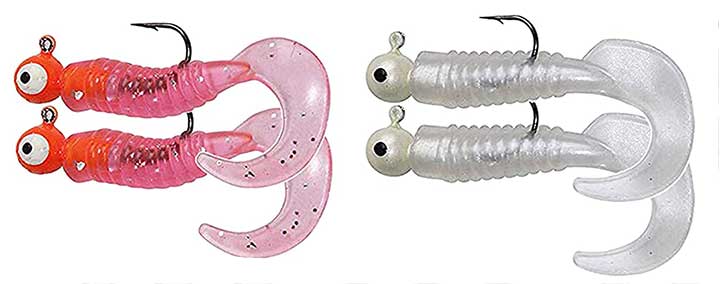
Jigs are another one of the famous mainstays of professional anglers as they can be employed in a variety of situations throughout the year. These lures are capable of catching a number of different game fish species in fresh or saltwater. They are designed to mimic a number of different prey species that fish target, but jigs are perhaps most popularly used by bass anglers to create the appearance of a crawfish. Curly tail jigs are also popular for bass, bluegill, crappie, and perch.
The basic concept of a jig is a metal ‘head’ that is connected to a hook. There are many different variations of this lure and saltwater jigs take on a whole new structure of their own as they are designed to look like diving or swimming bait fish. These lures are designed with a metal head that can be made of a variety of materials. A popular jig material is tungsten as it is a dense metal that allows for a smaller profile bait that can be thrown farther.
Jigs can be used with a variety of trailers or skirts. Bass anglers often opt for skirts with their jigs because they allow the lure to more closely resemble a crawfish and can easily be worked across the bottom at a leisurely pace in the cold winter months when fish are much more sluggish. Saltwater jigs can be rigged with a number of plastic baits that create an appearance of a general type of bait fish that many saltwater game fish species might show interest in. Gulp curly tail jigs add scent to the bait which can really help to get bites from saltwater fish such as small tarpon and fluke.
5. Blade Bait Flutter Jigs
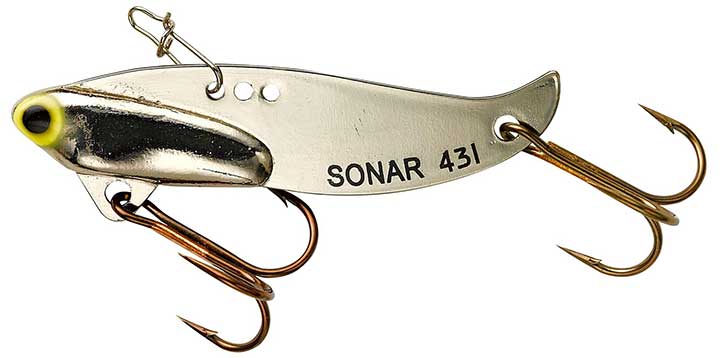
Another popular choice of lure for a variety of fish species such as smallmouth bass and walleye are blade bait flutter jigs. These lures are made with a number of different designs and are often best used in vertical ‘jigging’ techniques in which the angler drops the lure down to a certain depth. Then the jig is jerked upward quickly and then allowed to slowly flutter back down. The continuous motion is intended to appear like a suspended bait fish that is diving and feeding in a specific area.
Flutter jigs can be crafted to meet a number of different design patterns with many of them being made in a very simple, elliptical-shaped model that looks like a basic fish shape. Depending on the type of fry or bait fish in the area you’re fishing, be sure to match the flutter jig to the type of fish you expect your catch to be targeting at that time of year.
Flutter jigs are an especially easy type of lure to use and are great for winter fishing as they allow anglers to target fish that might be located in deep depths. There are multiple holes on the top of the jig the control the amount of flutter during the retrieve.
6. Scented Lures Such as Gulp and Power bait

In recent decades, scented lures have exploded in popularity. Some of the best brands in the fishing industry have released plastic lures that are designed to appeal to the fish’s sense of smell. These lures are produced in a large number of sizes and come in wide varieties of scents that range from things like garlic to a much more natural, fishy smell that will usually attract some level of attention from any kind of fish species.
These types of lures are most famously manufactured by Gulp or Powerbait, which are companies that almost exclusively make scented lures. Early models of this type of lure were a simple plastic design that was sealed in a bag or jar of oily scent-filled liquid. However, early baits had a reputation for the scent being quickly expelled after fishing for a short amount of time. Now, companies have designed plastic lures that are made with scents that are absorbed better into the soft plastics. This carries the scent for much longer periods of time, making it possible for an angler to use the bait longer leaving a better scent trail.
These scented lures are highly popular for catching species like crappie, fluke, striped bass, and other fish that rely on smell as much as they do sight. They are a great option in places where using live bait is illegal or difficult. In some cases, these scented baits will even outfish live bait.
7. Chatterbaits
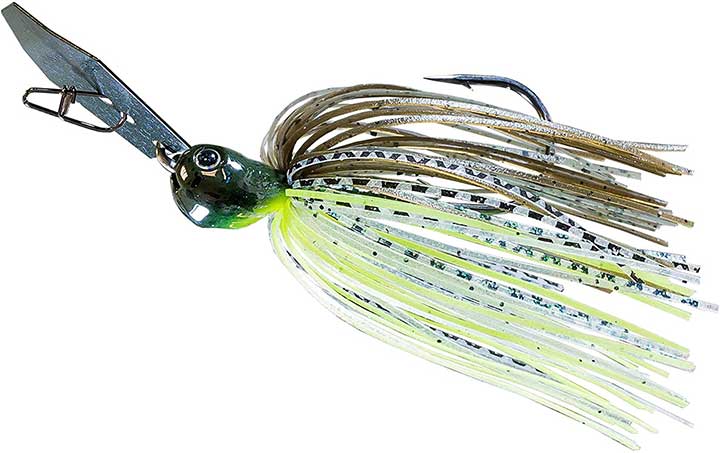
Chatterbaits are a relatively new phenomenon in the fishing world as they were designed less than two decades ago by a professional angler named Ron Davis, Sr. These lures closely resemble spinner baits in many ways, but have a unique design that gives off a very different, attractive vibration that is made to catch the attention of mature fish.
These lures are designed to produce a higher level of vibration, which is often referred to as ‘chatter’ by those who swear by the lure’s success. The chatterbait actually got its name because anglers joked that it produced such a vibration that it could make one’s teeth ‘chatter.’ Today, they are a very popular lure for bass anglers throughout the world.
They come in a variety of sizes and colors, but most will have the same basic design that operates using a small, square-shaped ‘blade’ that is loosely attached to the eye of the hook. The blade rapidly clinks back and forth when an angler retrieves the lure. This creates the trademarked chatter effect that can be productive in catching bass when no other lure seems to work. Z-Man Chatterbaits are top of the line but are quite expensive.
8. Buzzbaits
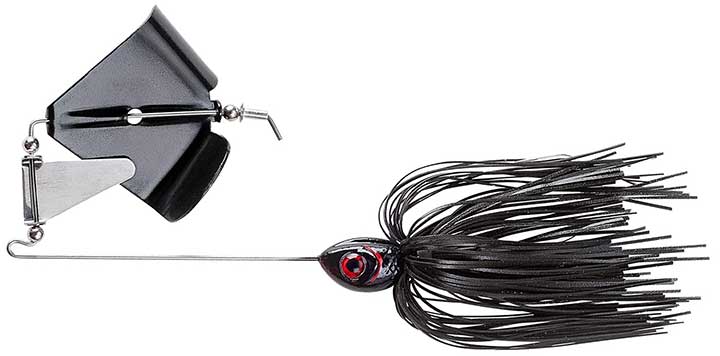
One of the most exciting lures available to anglers today is the buzzbait. Engineers, biologists, and professional anglers all seem to disagree on exactly what it is about this lure that makes it so appealing to fish, namely largemouth bass. Some argue that it creates a large amount of water displacement and noise, which they believe angers nearby fish. Others believe the buzzbait actually mimics the effect of a fleeing bait fish on the top of the water that might be rapidly swimming away to escape being eaten. Regardless of just what fish think it is, the buzzbait is extremely effective in certain conditions.
It’s most popular during the summer months when fish usually turn their attention toward the water’s surface in search of a potential meal. However anglers have successfully used buzzbaits in the late spring and fall as well. Many times, experienced anglers claim that buzzbaits seem to attract the attention of larger fish.
The buzzbait works by an angler steadily retrieving it across the surface of the water so that the unique ‘blade’ design works to actually churn the water. This creates a ‘buzz’ effect. There are many different buzzbait designs and some new companies are creating models that have more components to create a ‘clicking’ sound along with the blade’s churning effect.
9. Umbrella Rigs
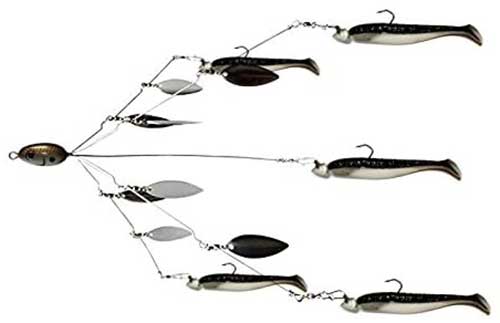
The concept of using more fishing lures to catch fish is one that the umbrella rig is based on. It’s a relatively new lure for freshwater fishing that was initially designed in 2011 by Andy Poss. He wanted to create a lure that mimicked the effect of a school of fish that swim together in a close, tight formation. He got the idea for the lure after watching a tuna chase a school of sardines. This is also commonly called an Alabama rig.
Umbrella rigs are made in such a way that they appear to look like the basic frame of an umbrella as the narrow wires connect multiple bait fish, or swim baits. These umbrellas can come in a variety of sizes and will often feature five or more ‘heads’ or swimbaits on a single lure. Depending on the area will depend on how many hooks can be used. Usually, it is three hooks or 5 hooks.
They are especially heavy but are very effective in producing strikes at times when other lures simply don’t seem to work. Since the umbrella rig actually does closely resemble a small school of fish underwater it can quickly garnish the attention of predator fish. Many saltwater anglers use large umbrella rigs to troll for species like striped bass and bluefish. This is a good lure for fish that focus heavily on targeting schooling bait fish in open water.
10. Diving Plugs/Crankbaits

Diving plugs are uniquely-designed lures that have a very distinct curved bill that protrudes outward. This bill causes the lure to dive down as it is retrieved or trolled by the angler. Shallow diving bills or lips are referred to as ‘crankbaits,’ and typically dive less than 6 feet. Diving plugs are made to dive to specific depths based on the lure design, amount of line let out, and the retrieval speed.
Many times, crankbaits are used to mimic the motion of a swimming bait fish They can also create the motion of a fleeing crawfish near the bottom. Like other types of lures, there are many variations of diving plugs that come in all shapes, sizes, and colors. It’s best to select one that closely resembles the bait fish in the specific body of water you plan to fish.
This lure is especially popular during the cold weather months of the year when fish are so often suspended in deep water. During this time of year, thier are also fewer weeds to get caught in. The diving plug usually features treble hooks on each end. It can be jerked along to create the motion of a fleeing, wounded bait fish, or retrieved at a slow and steady pace to allow the lure to dive downward.
11. Jerkbaits

Jerkbaits are a uniquely designed lure that look somewhat like a crankbait, but are made to appear with a narrow design like a small minnow or bait fish. These types of lures come in a variety of different lengths and sizes, but the overall intention of the lure is usually the same. Instead of producing a diving motion when being retrieved, these baits are meant to be ‘jerked’ through the water to give the appearance of a wounded bait fish, struggling to make its way across the water.
These jerkbaits are designed with a small bill or lip that lets them stay down a few feet below the surface. They are not intended to be fished to great depths unless placed on a downrigger which is possible. The lure should be marked as a sinking, suspending, or floating lure. When the lure is paused the sinking will sink, the suspending will remail at its depth, and the floating will rise toward the surface.
These types of lures are highly effective most of the year, but especially during the warmer months of early spring when fish are usually searching for an easy meal in the form of a lone bait fish. Jerkbaits are often referred to as ‘stickbaits’ and can feature two or three treble hooks depending on their length. A husky jerk is a great option when fishing bass, musky, northern pike, walleye, and pickerel.
12. Soft Plastics
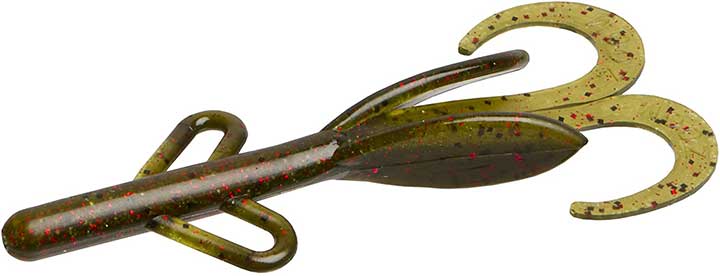
Soft plastics might be the most popular choice of lure for the modern bass angler as they can be used in a variety of situations throughout the entirety of the year. These lures come in a huge variety from the popular worm design to the unique crawfish or salamander shapes. Many newer models of soft plastics are made to appear more and more like real bait species, but most anglers argue that it is the bait’s action that elicits a strike rather than its appearance. The lure above is a green pumpkin baby brush hog with red specks.
Soft plastics can be rigged in a variety of different methods that include Carolina rigs, Texas rigs, wacky rigs, and many other forms of fishing that utilize the lure’s soft body to provide all the subtle movements that will undoubtedly attract the attention of nearby fish. Many of these soft plastic lures are now manufactured with specialized scents that are made to appeal to the fish’s sense of smell.
13. Flies
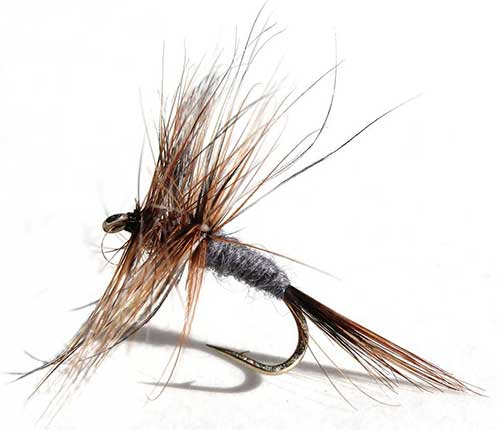
When it comes to trout fishing or going after other fish species that look for small prey options, flies are a great lure choice. They are most popularly used to catch trout and grayling in small rivers and streams and require the use of a fly rod to get the full effect and motion of a natural fly. Fly fishing is considered an art form by many enthusiasts as it requires an angler to have a graceful, precise casting form and technique that sometimes takes years to perfect.
Flies come in a wide variety, but they are actually effective in catching just about any species of fish since most types of fish will take advantage of an unsuspecting fly making brief contact with the water surface. Flies are now used to catch everything from bluegill to larger saltwater species like tarpon around coastal areas.
They are a very small lure choice, but can be highly productive in areas where flies are on the surface or aquatic insects are beneath the surface. Wet flies with bead heads that sink are actually more commonly used than dry flies. Most people think of dry flies though when they think of classic fly fishing.
14. Offshore Trolling Skirts
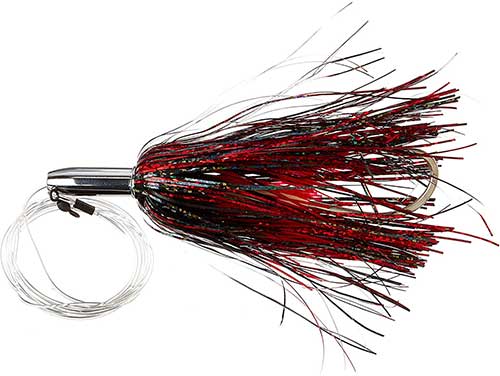
Offshore fishing is not for the faint of heart as it often requires hours of trolling for massive game fish species far out away from any shoreline. Trolling skirts are highly popular with anglers who target the many species that can be caught in the ocean currents many miles offshore. They feature a simple design that is made with a metal ‘head’ that is flanked with a colorful skirt.
These lures are most effective when trolling through open water as they will entice game fish to swim in and take a closer look. It is the skirt that provides the fast movements that mimic a squid or small fish swimming away that produces a strike for most species.
Trolling skirts come in a large variety of sizes and skirts while many newer models and are great for targeting species like mahi-mahi, tuna wahoo, sailfish, and many others. The lure above is a black and red billy bait that is great for catching tuna.
15. Flasher and Fly For Salmon Fishing
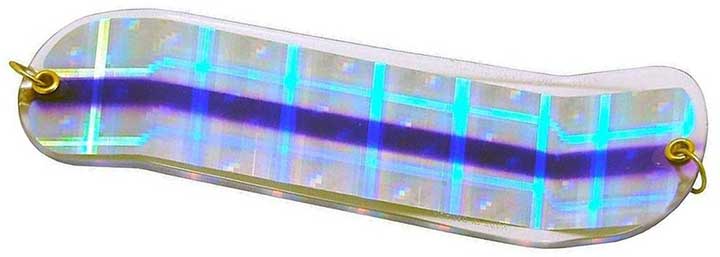
Salmon fishing is a unique style of angling that utilizes highly visible flashers and bait which are designed to catch the attention of salmon in the area. Salmon swim in schools and roll when they feed. Flashers are made of a metal plate or plastic which is usually painted to resemble the color of salmon. The flasher rolling looks like salmon feeding and other salmon come to investigate.
A leader that is two to three feet long is tied to a herring, fly, or spoon that acts as the lure to catch the fish. These are usually set to depths from 20-240 feet beneath the surface using a downrigger. Flashers are not required when salmon fishing but are commonly used. The UV purple haze shown above is a good color for king and silver salmon. Large flashers have high drag in the water but this is ok as troll speeds are slow from 1.5-3.5 miles per hour.
16. Worm Harnesses

Worms are always a solid go-to choice for many anglers and might be the best universal live bait choice in freshwater. However, the worm harness is quite different and is a lure used to target walleye and can catch perch and bass as well. Worm harnesses are basically designed to troll through the water and attract fish with a small spoon and an assortment of beads that are added to a line.
These lures often feature two hooks that trail behind the beads and the overall appearance of the lure is that of a worm. Anglers have great success when fishing for walleye by slowly trolling the worm harness along at a specific depth ranging from 15-80 feet deep.
Many anglers enjoy making their own custom worm harnesses as there are a large number of variations and concepts that have proven to be effective at catching fish.
17. Spoons

Fishing spoons are often underrated fishing lures. The Johnson weedless spoon is an old classic freshwater spoon that works well for catching bass, pickerel, northern pike, and musky. It is common to cast spoons with a spinning rod or trolled them on conventional rods. Spoons are often very heavy and can be cast far distances. Acme Little Cleo spoons are good a catching steelhead and salmon when trolling in the great lakes. Spoons also work well for trolling for walleye and salmon with downriggers.
There are actually many types of spoons that work for trolling for salmon in the ocean as well. Around river inlets, large spoons can be cast to catch salmon. Drone spoons are commonly trolled deep on a planer for king mackerel, cero mackerel, wahoo, and barracuda. In the north Atlantic, bunker spoons are trolled to catch large striped bass. Smaller spoons are both cast and trolled to catch bluefish. One advantage of spoons is that they are made of metal and hold up well against sharp fish teeth. Spoons are very versatile and it is important to retrieve them at speeds that give them the best actions. Heavy spoons are retrieved fast and lighter spoons are retrieved more slowly.
Frequently Asked Questions
What is the Most Popular Type of Fishing Lures?
There are a huge variety of different types of fishing lures, but the most popular ones are plugs, jigs, spinnerbaits, and soft plastics. These lures have a storied history with anglers all over the world and have been proven to work at any time of the year. Anglers have also used this assortment of lures to catch almost every type of freshwater and saltwater game fish species.
For anglers who are just starting out in using artificial lures, it’s best to stick to the simple and easy ones like soft plastics and spinners in order to truly get the most out of their efforts. Once they have mastered these types of lures, they can move on to things like plugs and jigs which might require a bit more effort and knowledge on just how to employ them to catch a certain type of fish.
What is the best color fishing lure?
For many decades, anglers have argued over the best color to use in fishing for just about every type of game fish species across the world. For years, bass angles swore that a chartreuse lure is far better than any other type of color, but recent research and lure color studies have proved that fish will strike at a major variety of colors depending on the time of year, as well as the type of prey they expect to find in a given body of water.
The most useful answer to this question for any angler is to use the color that best mimics the fish’s’ food source in the particular body of water where you plan to fish. This can vary from darker colors to bright yellows and other luminescent colored lures. If you have to select one single lure choice to go with, study up on the specific lure type and see what the experts typically use. If you are not sure what color is best then use light lures in clear water on bright days and dark lures in murky water and low light conditions.
How do I know what Lure to use?
Selecting the right lure truly comes down to a thorough knowledge of the fish in the body of water where you plan to target them. It can also depend on other factors like the time of year. The weather can also be important as fish are known to be finicky creatures that might exert great effort to eat one type of prey while totally ignoring another type.
Knowing just what lure is best to use in each situation comes down to a trial and error learning process on behalf of the angler. This process is part of why so many people enjoy fishing as there is always a hint of mystery and expertise on any given species at certain times.
Once you’ve started fishing and have mastered the art of a certain type of lure, it’s a good idea to expand your knowledge base. Trying out new types of lures and gaining useful knowledge about when and where to use them is fun and rewarding. In doing so, you will learn a lot more about the particular fish species you’re going after while also honing your skills and becoming a better angler in the process.
Popular Posts
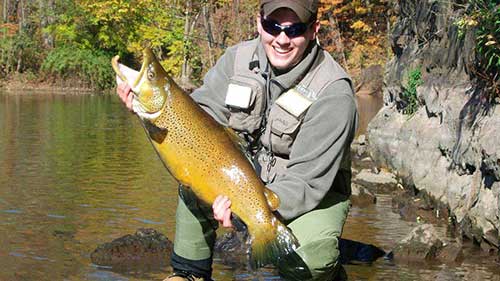
27 Best Trout Lures by Captain Cody
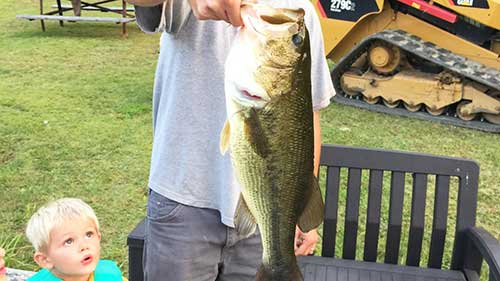
27 Best Bass Lures by Captain Cody
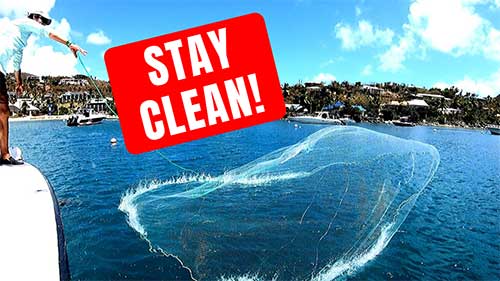
23 Best Cast Nets by Captain Cody
Captain Cody has worked on charter fishing boats in the Florida Keys, Virgin Islands, and Alaska. Growing up in Pennsylvania Cody has also done extensive freshwater fishing including bass fishing tournaments. Cody strives to provide detailed information about the best fishing gear and tactics to help both novice and experienced anglers have a more productive and enjoyable time on the water. Cody also has a background in aerospace engineering and neuroscience but really only takes pride in being good at one thing and that is fishing!
